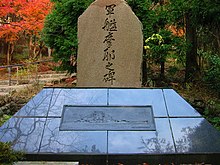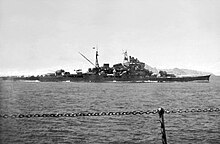Maya (ship, 1932)
|
Heavy cruiser Maya 1933
|
||||||||||||||||||
|
||||||||||||||||||
|
||||||||||||||||||
|
||||||||||||||||||
|
||||||||||||||||||
The Maya ( Jap. 摩耶 ) was a heavy cruiser of the Takao class of the Imperial Japanese Navy during World War II. The ship was named after Mount Maya , part of the Rokkō Mountains near Kobe . Unlike her sister ships, the Maya was converted into an anti-aircraft cruiser during her service life.
Construction and modernizations
The Maya keel was laid on December 4, 1928 at the Kawasaki shipyard near Kobe . After its construction period ended and the equipment was completed, it entered service four years later.
The cruiser Maya has been modernized several times.
The Maya was badly damaged in an American air raid on November 5, 1943 near Rabaul . For the repair work in Yokosuka , the ship was docked in December 1943 and the opportunity was used for a comprehensive conversion of the heavy cruiser into an anti-aircraft cruiser .
The 20.3 cm tower "C" of the main artillery , the 25 mm L / 60 Type 96 and 12 cm anti-aircraft guns in twin and single mounts were removed, as were the four torpedo sets, each consisting of two launch tubes. Within the four months that the work lasted, six Type 89 12.7 cm twin mounts were installed for air defense at greater heights and distances, as well as 66 25 mm L / 60 automatic cannons Type 96 for air defense at close range. The torpedo armament was doubled and the four torpedo sets, each consisting of two tubes, were replaced by four sets with four tubes each. The additional two twin mounts of the heavy flak , which found no space in the positions where the 12 cm guns had previously stood, were mounted at the height of the former tower "C", one each on port and starboard. More men were needed for the additional guns, so that the crew size grew to 1,105 seamen after the conversion.
A type 22 radar system based on magnetron technology with a range of around 24 km for the detection of surface targets at a wavelength of 10 cm was retrofitted to the bridge structure during this shipyard stay.
Southeast Asia and Aleutian Islands
At the start of the war in December 1941, the cruiser was used as a backup for operations during the Japanese invasion of the Philippines .
In search of fleeing Allied ships that were trying to escape from Java , Maya , accompanied by two destroyers, found the Stronghold , a British S-class destroyer, and sank it on March 2, 1942 . The Japanese ships together fired over 1200 shells during this action before the target finally went under.
On March 4, 1942, the naval association, consisting of the Maya , two of its sister ships and two destroyers, encountered a convoy of Allied ships, which, coming from Java, tried to reach Fremantle . After the escort, consisting of the Sloop Yarra , was sunk, the convoy was completely wiped out. A British minesweeper, a small tanker and a depot ship were sunk.
After returning to Japan in April 1942, the Maya spent a few days looking for Doolittle's fleet , whose planes attacked Tokyo on April 18 .
The Maya did not take part in the Battle of Midway , but accompanied Japanese convoys in May 1942 that went to the Aleutians to carry out operations against Attu and Kiska .
Guadalcanal
On November 13, 1942, she accompanied a battle group of three heavy cruisers and a few smaller ships as security, which was to bombard the Henderson Field airfield there during the Battle of Guadalcanal . The fleet, under the command of Admiral Mikawa on the cruiser Chōkai , carried out the night attack and set off in the direction of Shortland .
While retreating from Ironbottom Sound , the Mayan fleet was attacked by Enterprise carrier aircraft on November 14th . An American dive bomber missed the ship with its bomb, but collided with the main mast of the cruiser while intercepting its dive and fell on the port side on the deck. Several anti-aircraft grenades stored there exploded, killing 37 sailors.
Komandorsky Islands
At the beginning of March 1943, the Maya , together with the Nachi , two light cruisers and destroyers, were assigned to escort a supply convoy for Japanese army troops who were occupying the Attu islands near the commanders' islands . For their part, the Americans sent a combat group consisting of a heavy and a light cruiser and four destroyers to intercept the Japanese.
On March 27, 1943, the battle of the Komandorski Islands broke out . The Maya scored several hits on Salt Lake City and severely damaged the American ship. The Japanese cruiser also fired several torpedoes, but all of them missed their targets. The US destroyer Bailey's torpedo attack on the Maya was recognized in time, and she was able to avoid the four torpedoes. The operation was eventually canceled.
Rabaul
The Maya , part of Vice Admiral Kurita Takeo's 2nd Fleet, left Truk on November 3, 1943. The Americans feared an attack by the fleet on their landing forces, which were carrying out an operation against Bougainville , and decided to eliminate the Japanese fleet by air raids when they reached their base near Rabaul . The Task Force 38 launched on November 5, about 50 Sturzkampf- and torpedo bomber and as many fighters of two aircraft carriers . Atago and Mogami were damaged by bombs. The Maya was still able to gain speed and was about to leave port, but was hit by a bomb on her quarterdeck that was dropped by a Dauntless dive bomber. There was a fire at the height of the aircraft catapult on port side and numerous secondary explosions, which damaged the machinery below so severely that it was unable to maneuver. Other sources, however, report that the bomb in question took the direct route through the Maya chimney after it was dropped and thus exploded in the middle of the engine room.
After an emergency repair in Rabaul, the Maya moved to Japan in order to have the serious damage repaired in Yokosuka and to have the anti-aircraft armament reinforced. Between December 1943 and April 1944 it was repaired and converted into an anti-aircraft cruiser.
Philippines

When assembling the fleets for the Japanese attack on American naval units, which were preparing a landing in the Philippines in October 1944 , the Maya Vice Admiral Kurita Takeo's 2nd Fleet was assigned, the strongest Japanese task force in the sea and air battle in the Gulf of Leyte .
According to intercepted Japanese radio messages, the American high command of the submarine force for the Pacific (Com-SubSoWesPac) ordered two submarines to the Palawan Strait on October 11, 1944 to attack expected Japanese naval units.
After the fleet, led by a sister ship of the Maya , the Atago , left Brunei on October 22nd, it set course for Palawan . The waters around the narrow part of the Palawan Strait were dangerous and criss-crossed by reefs and shallows , so that Kurita grouped his ships in a tight formation. The capital ships of the fleet were grouped in two columns. The starboard column, led by Myoko , followed by Haguro , Maya and the battleships Yamato and Musashi , was shielded from the outside by four destroyers. The association ran zigzag courses to make submarine attacks more difficult.
The American submarine Dace had discovered the formation on the morning of October 23, and its commander mistook the Maya for a battleship. So he let the Myoko and the Haguro pass and shot a torpedo fan on the heavy cruiser and hit the Maya with three torpedoes .
The Maya immediately listed and was destroyed by a major explosion just ten minutes after the hits.
The destroyer Akishimi rescued 769 survivors and transported them to the battleship Musashi . 335 sailors and the commander perished in the attack, explosion and sinking of the Maya . A memorial stone at Kobe today reminded of the ship and crew.
wreck
The research vessel Petrel of the late Paul Allen located the wreck on April 19, 2019 at a depth of around 1,850 m. Most of the ship sits upright on the ocean floor, with the exception of the demolished bow.
literature
- Japanese Cruisers of the Pacific War , Eric LaCroix, Linton Wells, US Naval Institute Press, 1997, ISBN 0-87021-311-3
- Takao Class , Gakken Pacific War Series, Number 16, Gakken, Tokyo, 1997, ISBN 4-05-601685-2
Web links
Individual evidence
- ↑ Japanese Cruisers of the Pacific War , p. 329
- ^ Japanese Radar and Related Weapons of World War II, Yasuzō Nakagawa, 1998, Aegean Park Press, ISBN 0-89412-271-1
- ↑ United States destroyer operations in World War II, Theodore Roscoe, 1953, US Naval Institute Press, ISBN 0-87021-726-7 , page 161
- ^ A battle history of the Imperial Japanese Navy, 1941-1945, Paul S. Dull, 2007, US Naval Institute Press, ISBN 1-59114-219-9 , p. 292
- ^ History of United States Naval Operations in World War II: Volume 6, Samuel Eliot Morison , University of Illinois Press, 2001, ISBN 0-252-06997-8 , page 328
- ↑ United States submarine operations in World War II, Theodore Roscoe, US Naval Institute Press, 1947, ISBN 0-87021-731-3 , page 391 and following
- ^ The Battle of Leyte Gulf: October 23-26, 1944, Thomas J. Cutler, 2001, US Naval Institute Press, ISBN 1-55750-243-9 , pp. 96 and 97
- ^ The Battle of Leyte Gulf: October 23-26, 1944, Thomas J. Cutler, 2001, US Naval Institute Press, ISBN 1-55750-243-9 , pages 101 and 102
- ↑ RV Petrel Facebook from June 30, 2019

